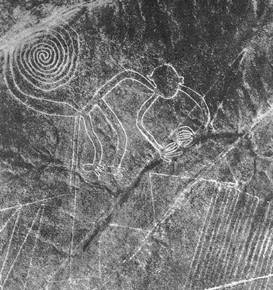Nazca Lines
| Lines and Geoglyphs of Nazca and Pampas de Jumana* | |
|---|---|
| UNESCO World Heritage Site | |

| |
| State Party | |
| Type | Cultural |
| Criteria | i, iii, iv |
| Reference | 700 |
| Region** | Latin America and the Caribbean |
| Inscription history | |
| Inscription | 1994 (18th Session) |
| * Name as inscribed on World Heritage List. ** Region as classified by UNESCO. | |
The Nazca lines are a series of geoglyphs located in the Nazca Desert, a high arid plateau that stretches more than 80 km (50 miles) between the towns of Nazca and Palpa on the Pampas de Jumana in Peru. They are believed to have been created by the Nazca culture between 200 B.C.E. and 700 C.E. There are hundreds of individual figures, ranging in complexity from simple lines to stylized hummingbirds, spiders, monkeys, fish, sharks, llamas and lizards. Despite having been studied for many years, archaeologists still do not have a consensus for the purpose of the forms. Hence, the Nazca Lines remain one of the many mysteries of the ancient world.
Overview
The Naszca culture flourished from the first to eighth centuries AD beside the dry southern coast of Peru in the river valleys of the Rio Grande de Nazca drainage and the Ica ValleyCite error: Closing </ref> missing for <ref> tag and Woodman's work has been rebutted.[1]
Environmental concerns
According to Viktoria Nikitzki of the Maria Reiche Centre, an organization dedicated to protecting the Nazca Lines, pollution and erosion caused by deforestation threaten the continued existence of the lines. She is quoted as saying "The Lines themselves are superficial, they are only 10 to 30cm deep and could be washed away... Nazca has only ever received a small amount of rain. But now there are great changes to the weather all over the world. The Lines cannot resist heavy rain without being damaged."[2] Mario Olaechea Aquije, the archaeological resident from Peru's National Institute of Culture in Nazca, Peru, and a team of specialists surveyed the area after the flooding and mudslides occurring in the area in mid-February of 2007. He announced that "the mudslides and heavy rains did not appear to have caused any significant damage to the Nazca Lines," but that the nearby Southern Pan-American Highway did suffer damage, and "the damage done to the roads should serve as a reminder to just how fragile these figures are."[3]
Notes
- ↑ http://www.hallofmaat.com/modules.php?name=Articles&file=article&sid=96 Grounding the Nasca Balloon by Katherine Reece
- ↑ Meghji, Shafik. " Flooding and tourism threaten Peru's mysterious Nazca Lines", The Independent, July 17, 2004. Accessed April 02, 2007.
- ↑ Living in Peru. "Peru: Nazca Lines escape mudslides", Living in Peru, February 20, 2007. Accessed April 02, 2007.
ReferencesISBN links support NWE through referral fees
- Aveni, Anthony F. (ed.) (1990). The Lines of Nazca. Philadelphia: American Philosophical Society. ISBN 0-87169-183-3
- Aveni, Anthony F. (2000). Between the Lines: The Mystery of the Giant Ground Drawings of Ancient Nasca, Peru . Austin Texas: University of Texas Press. ISBN 0-292-70496-8
- Haughton, Brian. (2007). Hidden History: Lost Civilizations, Secret Knowledge, and Ancient Mysteries. Career Press. ISBN 1564148971
- Lambers, Karsten (2006). The Geoglyphs of Palpa, Peru: Documentation, Analysis, and Interpretation. Lindensoft Verlag, Aichwald/Germany. ISBN 3-929290-32-4
- Reinhard, Johan (1996) (6th ed.) The Nazca Lines: A New Perspective on their Origin and Meaning. Lima: Los Pinos. ISBN 84-89291-17-9
External links
- Nazca lines at the Open Directory Project
- Palpa, Peru Google map
- Palpa, Peru Google map
- The Nazca Lines from Satellite and Videos
- Nazca Lines and Culture
- The Nasca Lines Project (1996-2000)
- Nazca Lines
Credits
New World Encyclopedia writers and editors rewrote and completed the Wikipedia article in accordance with New World Encyclopedia standards. This article abides by terms of the Creative Commons CC-by-sa 3.0 License (CC-by-sa), which may be used and disseminated with proper attribution. Credit is due under the terms of this license that can reference both the New World Encyclopedia contributors and the selfless volunteer contributors of the Wikimedia Foundation. To cite this article click here for a list of acceptable citing formats.The history of earlier contributions by wikipedians is accessible to researchers here:
The history of this article since it was imported to New World Encyclopedia:
Note: Some restrictions may apply to use of individual images which are separately licensed.